
|   |

|   |
Highlights of Natya Kala Conference 2019 - Ramaa Bharadvaj e-mail: ramaabharadvaj@gmail.com Photos: Ramaa Bharadvaj January 3, 2020 Natya Kala Conference 2019 started with a bang! What excitement and celebratory participation from the dance community! Kudos to Rama Vaidyanathan and Akhila Krishnamurthy for envisioning this year's conference so well. Day 1 highlights Vaibhav Arekar's reinterpretation and exploration of the Margam was simply brilliant. Poetry, space, shapes, stories, emotions were interwoven with such intelligence and surprises, accompanied by evocative music (Kartik Hebbar on vocal and Mahesh Swamy on flute were outstanding) and was so wonderfully lit by Sushant Jadhav. 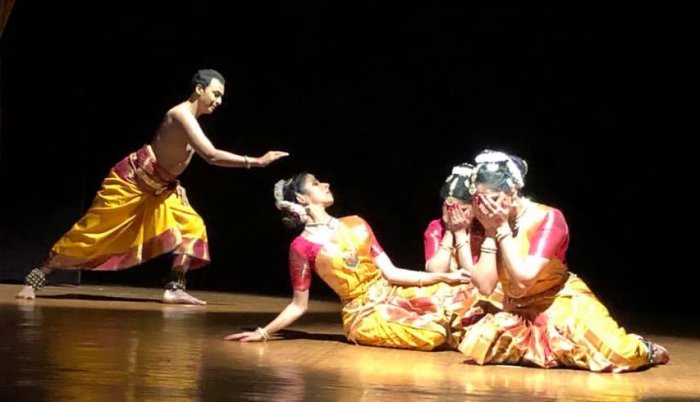 Vaibhav Arekar and Sankhya Dance Company  Sudharani Raghupathy, Padma Subrahmanyam and Chitra Visweswaran And what words can there be to describe the revisiting of the legendary Viralimalai Kuravanji by Padma Subrahmanyam, with Chitra Visweswaran and Sudharani Raghupathy. Paddukka simply stole the show with her spontaneous inimitable humour (which had the entire theater rolling with laughter) and her recounting of the stories of how she learnt the original entry steps of her role from the 90 year old devadasi Annammaa (who had never taken a car ride in her entire life). What a spectacular start to the conference. Day 3 highlights 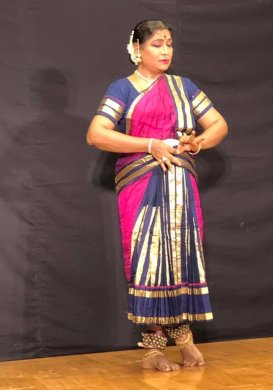 Narthaki Nataraj The Spanda Dance Company (direction by Leela Samson) was vibrant, energetic and told stories of relevance. A River's Story was complex and intriguing musically (Rajkumar Bharathi music and lyrics) as well as conceptually and choreographically. However, the continuous, non-stop use of group patterns got to be an overload for me losing some of its charm and surprise. Rajika Puri's presentation of Bharatanatyam trends of the past with vintage clips of Bharatanatyam divas of the 1960s and her enchanting style of delivery were both informative and enjoyable. Why should paper presentations be dry and yawn inducing? Rajika gave it to us like a story turning it into a wow session for all. 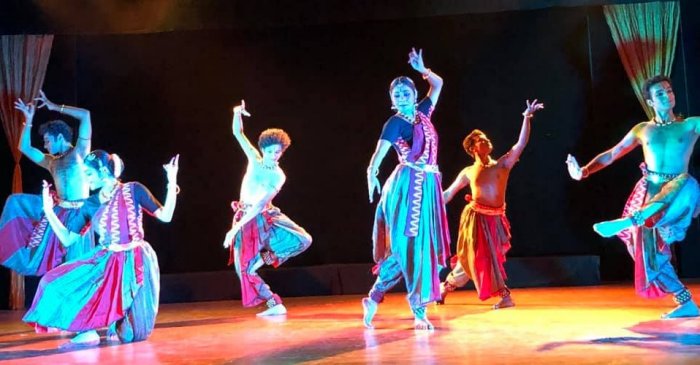 Spanda Dance Company 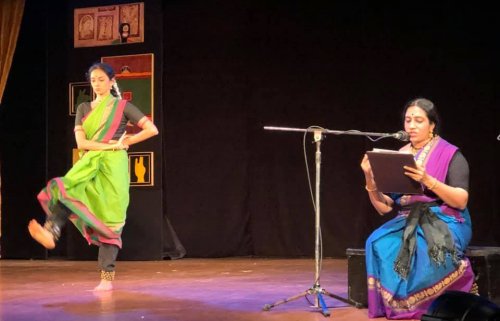 Lakshmi Parthasarathy Athreya and Uma Sathya Narayanan Uma Sathya Narayanan and Lakshmi Parthasarathy Athreya did a fabulous job of exploring and interpreting basic movement patterns from Sangita Saramruta. Besides just learning dances and performing, I hope more young dancers are inspired by this kind of work which will enrich the learning/teaching of foundation-exercises. Day 4 highlights 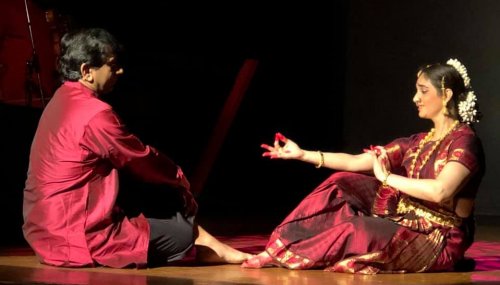 Yadavan & Nina Rajarani Nina Rajarani from UK gave an interesting staging of her work Kaadhala. Her orchestra was part of her dancers - her husband Yadhavan not only sang splendidly but his presence and weaving in and out through the dance (and dancers) was something I enjoyed immensely. Rama Vaidyanathan is known for her creativity and unique thought process as a choreographer. But today she stunned us all with a most brilliantly designed, exciting session - Transparent Critiquing. One should have been there to experience the thrilling 2 ½ hours which flew by like 2 ½ minutes. Rama chose 4 brilliant young dancers - Navia Natarajan, Praveen Kumar, Janaki Rangarajan, and Lavanya Ananth - who were given 16 minutes each to present a dance based on a "Question". Four well known dance critics were chosen - each to review a dancer assigned to them. After the 4 performances, the critics were ushered away to a private room where they had 45 minutes to write a review. In the meantime, the audience got to critique/comment on the dancers and question them on their choreographic processes. While Lavanya and Navia chose safe themes from Ramayana based characters, Praveen Kumar showed his choreographic strength with an elegant depiction of the body as the instrument which birthed syllables and sacred sounds. He ended with his question (in English text) - why has this intended gaze of the body as a divine instrument blurred into a mere narcissistic one today? However, in order for text to be really effective in dance, it must be rendered poetically, or else it snuffs the lyricism created by the dance. (Anita R Ratnam's rendition of English text in her new work Nachiyar Next is an example of how to do it right). I hope Praveen will work on that last part to create a script and rendition style that will let the text flow more organically with his wonderful dancing. 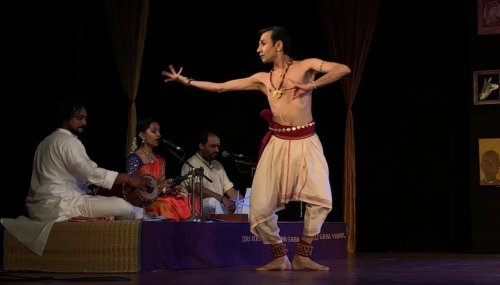 Praveen Kumar It was Janaki Rangarajan who gave the most daring and original presentation "tick-box". Her question was based on her own personal experience as a dancer who incorporates the extremely fluid Bharatanrityam movements in her choreography - "I am criticised as being too masculine sometimes and too erotic sometimes. Am I not the container of both male and female energies in me? Am I not Ardhananarishwari? How many boxes should I tick to please the critics and their image of what I ought to dance like?" Her performance resonated deeply with the young dancers in the hall who received it with thunderous appreciation. Then the critics returned!!! Sparks and fireworks flew when Janaki's work was "reviewed" as "inedible food on a fine silver platter" by her assigned reviewer. As audience member, it was dancer Ramya Ramnarayan who questioned the use of this kind of sensational jargon and demanded a constructive and useful critique that will benefit the dancer. And the ever gorgeous, ever bold Padmini Ravi of Bengaluru (also audience member) made a powerful point defending the artist's right to create what resonates with him/her. As a dancer who has successfully survived in this field for over 5 decades, here is my view on all this - we dancers cannot and should not get so overly attached to our work. It requires a certain witness attitude in order to both create works of enduring strength as well as to let both morale destroying criticism or ego boosting praise to slide off like water droplets on lotus leaf. We dance about Lord Rama as the epitome of equanimity. What is the use of all that if we cannot even imbibe one 'Rama- Quality' in us? In my looooong career I have had my share of good reviews and not so good reviews. One LA Times reviewer who gave me a nasty review one year became an ardent admirer two years later. That's life! Our work is born of our inspirations which are divine anyway. Surrender the fruits of it to the same Divine and continue creating with love for your chosen path and conviction in your purpose. As a curator of a major Arts Festival now in India, and as a past panelist for numerous State and National arts grants-agencies in the US, let me tell all young dancers this secret - I have never in the past (and I still don't) read any review sent by an applicant! It is THEIR WORK and ONLY their work that helps me make up my mind. A review is one person's opinion! If they are responsible writers and knowledgeable scholars, seek their advice - it will help you grow. If they revel in nastiness, just shun it as a cranky scream. But never lose heart, and NEVER stop creating - as they say in wedding blessings "what God has joined together, let no man (or woman) put asunder." In conclusion here is a suggestion to the critics- why don't some of you consider becoming dramaturgs? In addition to critiquing a show AFTER it goes on stage, why not offer your valuable inputs to dancers BEFORE it goes on stage? Day 5 highlights Alarmel Valli's 'My journey through dance' 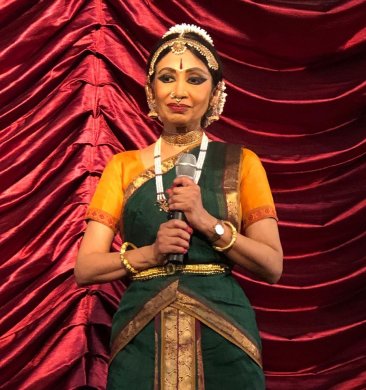 Alarmel Valli Presenters clearly know the time given to them for their presentations. Then, why do they spend half the time flipping pages of their stapled papers in panic, and repeatedly asking, "How much time do I have?"; Exclaiming, "What? ONLY 10 minutes left?"; Wondering, "Will I be able to finish everything?"; Murmuring, "I still have this, this, AND this to cover" and so on! The audience who waited with bated breath for Alarmel Valli's session on her journey through dance got plenty of this annoying drama. I wonder if these super-stars take their appearance at NKC for granted because they are called year after year, or if we are supposed to accept it as part of their 'manodharma-performance'! Although Valli came dressed in full dance-regalia and accompanying orchestra, she danced only a couple of brief rhythm sequences because her vocalist could not be there due to some unforeseen circumstances. As for her presentation, it was more of a wandering conversational reminiscence than a tightly prepared narration, but she shared it with poetic elegance. It was filled with anecdotes (although previously heard ones) about her experiences with her gurus who were full of integrity and depth of knowledge, the enriching influence of her mother, the need for observational powers, the importance of learning music, the necessity of poetry and practicing essay-writing for dancers. "Dance is also a language - when you craft one language well, the same rules can be applied to another language" was one of her gems worth mentioning. She concluded with suggesting two choreographic principles to hold in mind - The first from her teacher on the importance of 'sarakku' or movements which should first form the bedrock of the choreography versus 'minukku' or embellishing movements like twirls and poses which are later added for beauty. The second principle was from her mother who told her never to dance to impress. "If the poem speaks to you, then you dance with conviction and truth to yourself." Abhinaya Adventures 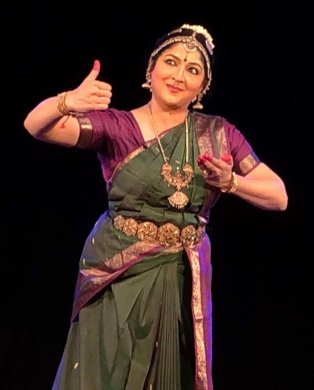 Srinidhi Chidambaram 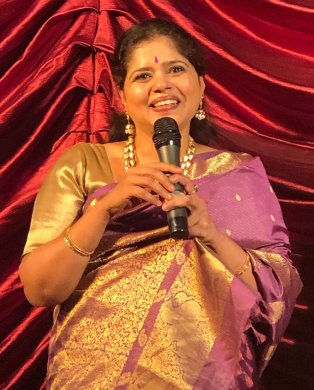 Sudha Raghuraman Srinidhi's portrayal (to Vairamuthu's Tamil poetry) of a modern-day working woman who balances her day at the office and at home taking care of her little one, was the most charming of them all. She suggests that her little one fall asleep listening to a lullaby on Ipad because mummy has to go to the office and that only on Sundays she can perform her motherly duties. Srinidhi used the tools of Bharatanatyam gestures to create images of Ipad, cell phone, watch, handbag, computer, etc. But she must be totally out of touch with the reality of traveling in a crowded bus. I mean, who carries a handbag slung over the shoulder in a bus or even while walking on the street? Ask us, who do it bravely, and we will teach you the gesture for "clutching it for life"! 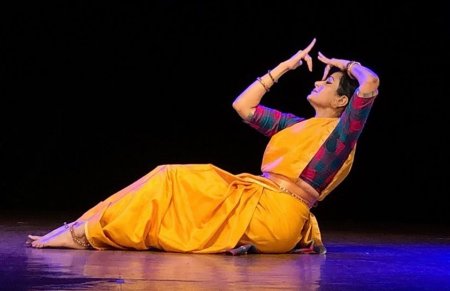 Vidhya Subramanian Vidhya Subramanian looked stunning in her lovely portrayal of Radha and Krishna exchanging not only hearts but each other's attire. The image that is etch-worthy in the mind is the one when Krishna rubs forehead with his beloved to transfer his 'tilak' onto her forehead (see photo). But I kept wondering "how does one do that without tilting the head? Won't noses come in the way?" What an unromantic oaf I am! 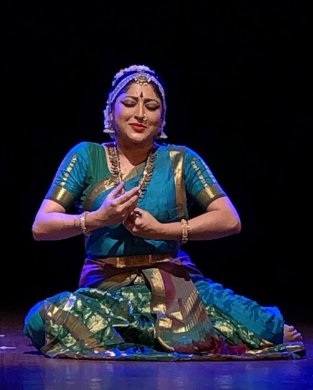 Lakshmi Gopalaswamy 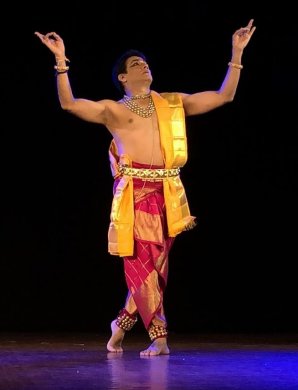 Sathyanarayana Raju Sathyanarayana Raju stood his own among the three ladies with his involved abhinaya but I wish he had chosen to depict a male perspective. Lakshmi Gopalaswamy was adorable when she spoke, and elegant when she danced. She has such an amiable stage presence that you can't help but fall in love with. Her song was from the Kuchipudi repertoire about Krishna's feet, that she chose to interpret with Vedantic overtones. Choreography Panel 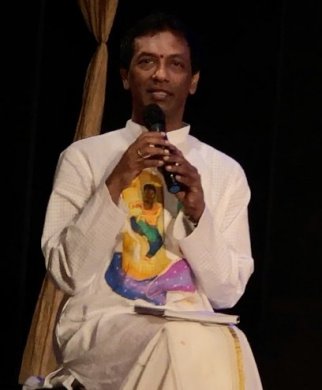 Shankar Kandasamy These panels are turning out to be mostly exercises in who-delivers-the-best-one-liners. Such is the limited time each artist gets, and such was the case with this one too. Sheejith Krishna (Don Quixote), Chitra Dasarathy (Roots), Geeta Chandran (Anekanta based on Jain philosophy) all had time to show minuscule amounts of videos of their fascinating choreographic works, but what they spoke did not really throw much light on their choreographic thought processes or nuances. It was Shankar Kandasamy who utilized his time most purposefully and gave the young (and not so young) dancers in the audience valuable takeaways. He used his video not to flaunt his work, but as a spring-board to share his principles of group choreography - level changes, weaving, relay or canon, revelations, creating a chorus, creating a pageant, convergence / divergence, echoing each other, encountering and traveling across stage, image imprints, the rationale behind randomness and chaos, graphing the stage with meaning and form and so on. His intent is to create templates with these ideas which already choreographers use instinctively, but without these specific tabulations so that it can be useful for young choreographers. Bravo Shankar! These panels would be more useful if there were fewer artists on them so that each can get at least 15 minutes to share their viewpoints. ANJASA by Apsaras Arts from Singapore 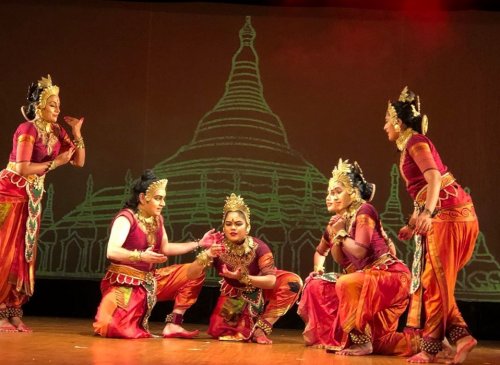 Anjasa Swami Chinmayananda once said this about new ashram-buildings that are constructed - that every stone in the building must justify its presence, must be put to use, and must earn its place there. I see the same applying with a dance work containing more than one dancing body. The presence of every extra dancer on stage must be choreographically justified. This dance season, I got to see group and duet choreographic works by well-known artists. Unfortunately, while some inundated me with over-use of constant patterns and tired the eyes and mind, some were so predictably monotonous, some were reminiscent of previous works of the choreographer that it left me with a deja vu feeling, and some were plain bland and sleep-inducing. But on the final day before I left Chennai, NKC gave me an aesthetic treat in 'Anjasa' by Apsaras Arts of Singapore. The various Buddhist monuments and their significance in the timeline of Buddhism were depicted breathtakingly. Aravinth Kumarasamy who scripted, and artistically envisioned this work deserves applause for this difficult theme executed effectively. There were no stories, only concepts that were portrayed, and the danger was that it could have taken on a documentary-style feel. But ANJASA effortlessly escaped that trap through its engaging choreography (by Mohanapriyan Thavarajah) which took us through Buddhist monuments in Nepal, Sri Lanka, India, Cambodia, Indonesia, and Myanmar. Just because there were 8 dancers, they were not thrust on us in every piece at every second. The layering with which they were introduced was soothing to watch. The dancers were adequately trained if not superbly, but what is important was that they were utterly pleasing to watch. The creative way in which each monument slowly built itself like a 'kolam' (hand-drawn floor patterns) on the backdrop, as the dances unfolded, offered a dainty dynamism to each scene. The stunning costumes and the magnificently composed music by Aravinth (he had used Indian melodies but brought in instruments of the various cultures that were being depicted) all added to the overall aesthetic experience. Bravo Aravinth! The only thing that disturbed the delicateness of this work and even distracted me, was the pungent, almost neon-like lighting. Lighting designers like Gyan Dev, Victor Paulraj, Sushant P Jadhav, have all proven that lighting can be powerfully effective without flashing colors almost violently at our eyes. ANJASA deserves that delicacy. Thoughts in conclusion And thus, the Natya Kala Conference of 2019 comes to successful completion. Rama Vaidyanathan and Akhila Krishnamurthy (and her Aalap team) created much participatory excitement among young dancers through their warmth and involvement. Of course, there are those who opine that there might have been excitement, but there were no solid takeaways offered by the curatorial aspects of this particular conference. My opinion is that learnings come not only from being spoon-fed theories, concepts, and nothing-but-excellence all the time. The BEST lessons actually come from watching what does not work, and things that go awry, and things that disturb you. So, if there were moments that made you uneasy or restless those are probably precious moments worth retrospection. And I must say this to that one lady who stood up after Janaki Rangarajan performed her dance-question in her dialogue-evoking performance. The lady all-knowingly declared, "You seem to be defensive in your presentation. THIS is not the venue for that." Say what!? Hello lady! THIS was EXACTLY the place to create such dialogues, ask questions, debate and even have the luxury of coming to no dogmatic conclusions. I hope NKC and other conferences will always provide the space for artists to not be "safe" and "secure" all the time and to take the risks they need to take to explore, discover, challenge themselves, and grow. I end this recap with that important caveat that all of the above is JUST ONE PERSON'S OPINION. Do not take it too seriously. What is important is you all never stop creating, dialoguing and creating beauty in the world through your art! 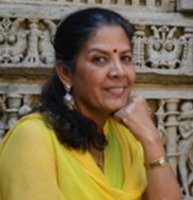 Ramaa Bharadvaj is an acclaimed performer, choreographer and author. She lived in the US for 31 years and was the recipient of multiple Lester Horton Awards for her choreographies. She currently lives in Bengaluru. She travels, writes and speaks on the arts for diverse groups and also teaches and co-curates a national performing arts festival at Chinmaya Naada Bindu Gurukul, Pune. |